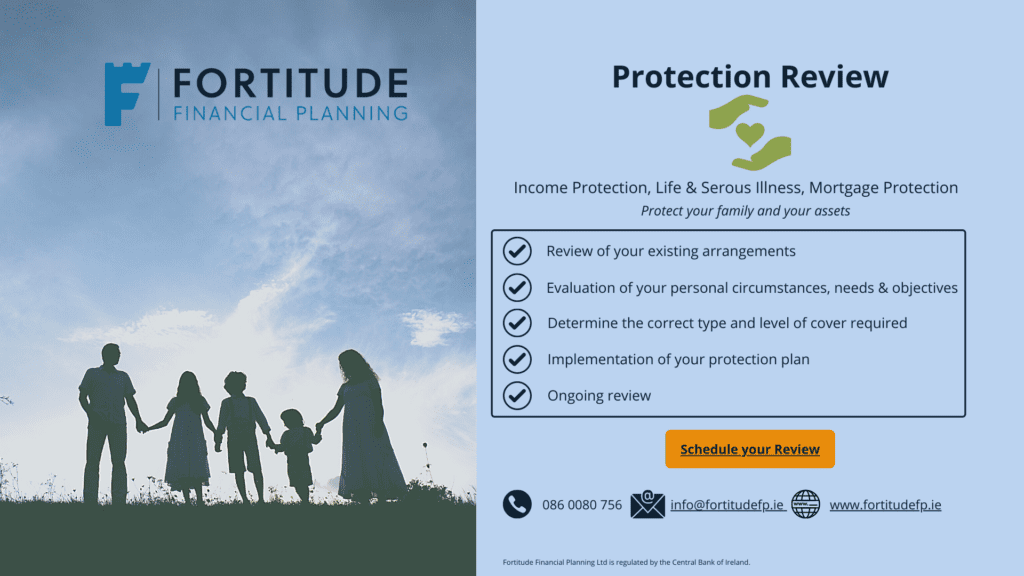What is income continuance or income protection?
Recently, we covered the importance of financial protection as part of a financial plan.
You can read this here.
Financial protection is the solid foundation of any financial plan.
Income continuance is a form of financial protection.
But what exactly is it?
What does it cover?
Under what circumstances does it pay out?
Does it actually pay out?
Weekly, in our practice, we come across these questions.
We re-iterate, at Fortitude Financial Planning, we aim to cut through financial jargon.
Just simplify stuff.
We will go into a bit more detail on this cover.
What it is, what it covers, how important it is and who should have it.
We will also cover some of the high level variable elements of the cover.
If you earn an income, this is relevant to you.
Schedule Your Protection Review
What is Income Continuance
Simply, income continuance is a type of financial protection that pays you an income if you are unable to work due to illness or injury.
You may be entitled to the state illness benefit if you can’t work due to illness or injury.
Importantly, this is only €10,816 per annum.
Clearly, that is a significant reduction in income from any salary you are earning.
Let’s assume you earn €40,000 per annum.
You fall ill or get injured and can’t work, time ticks by, your employer’s sick pay finishes.
Your income drops to €10,816 per annum (€900 per month).
Note, if you’re self-employed, you don’t receive any state benefit.
That’s a 73% reduction in your income.
Importantly, if you had income continuance, your income continuance would kick in and start paying.
You would now be in receipt of a significant % of your regular salary, even though you were injured or sick.
Income continuance is one small part of your cohesive financial strategy.

How does Income Continuance work?
A level of your salary is covered from the outset of the policy.
This is typically 50%, 66% or 75% of your salary.
We will factor in the state illness benefit if you are entitled to it.
Once your income continuance is on cover, you pay the premium.
In future, if you fall ill or get injured, after the selected deferred period has expired, you claim.
Assuming your claim is successful, your income continuance kicks in and your replacement income is paid.
Paid until the earlier of you going back to work or selected retirement age on your policy.
Deferred period
A deferred period is chosen at outset.
This is typically 3 or 6 months.
Alternatively, there are other shorter and longer deferred periods but those are most common.
After the deferred period is up, this is when a claim is submitted.
We always try and tie the deferred period to any employer sick pay you will receive.
For example, if your employer will pay you 6 months of sick pay, your deferred period would be 6 months.
There is no point in having income protection on a 3 month deferred period if your employer will pay you in full for 6 months.

Index Linking the Cost and Cover
At outset, the option to increase the cover (and cost) every year can be selected.
This is due to inflation.
Importantly, however, if you cover 75% of your salary and your salary doesn’t increase, it is of no use.
Benefit Increasing In Payment
An option is available that increases your claim payment if a claim is made.
Unquestionably this is a good variation to combat future inflation.
Guaranteed or Reviewable Premium
When we place the cover, there is the option of a guaranteed or reviewable premium.
Guaranteed means the rate the provider of the cover uses to calculate the cost cannot be changed in future.
Whereas, a reviewable premium, the insurer could review the rate used to calculate the cost and this could in turn increase the cost in future.
Occupation Class
Without a doubt, your occupation will have a significant bearing on the cost.
There are 4 occupation classes.
Class 1, class 2, class 3 and class 4.
The cheapest occupation class to cover is class 1.
Some examples of a class 1 occupation are an administrator, an accountant, predominantly desk based.
When we move through the occupation classes, they become more expensive.
Simply, as the risk increases.
Some examples of a class 4 occupation are a painter and decorator, a fencing contractor or floor layer.
Undoubtedly more manual occupations.

Income Continuance Maximum allowable benefit
Important to note, there is a maximum level of our salary we can cover.
This is 75% of our salary less the state illness benefit.
If we could cover 100% of our salary there would be no impetus for us to go back to work if we were on claim.
Tax Relief on the cost of income continuance
Income continuance is one of the few arrangements we can claim tax relief on.
Revenue will cover 40% of the cost for you (assuming you’re a 40% rate tax payer).
It is viewed as such an important benefit that this relief is provided.
A slight change has occurred recently in how you get this.
Without a doubt, a huge benefit.
In addition, it’s easy to claim.
You assign a tax credit, essentially giving you the relief at source.
Is the Income Continuance benefit taxable?
Yes.
It is assessed like your normal income for tax purposes.
Assessable for income tax, USC and PRSI.
What does it cover?
Unlike a specified serious illness policy, income continuance covers you if you are unable to work due to illness or injury.
Let us look at 2020 claims statistics from Aviva (we are awaiting 2021).
The number one reason for claim was psychological.
Number two reason for claim was orthopaedic.
Cancer then comes in at number three.
Under a serious specified illness policy, clearly, reasons one and two would not be covered.

How Important is income continuance?
Once you earn an income, very.
Think about your annual salary, if this dropped to €10,816 per annum, how would your household cope?
Struggle at best I would hazard a guess.
Ultimately, if we can’t work due to illness or injury, our expenses remain the same.
Maybe even increase once we factor in medical bills.
Simple math, calculate your monthly expenses.
Would €900 per month cover them?
Everyone needs a level of income continuance.
Without a doubt it doesn’t have to be the maximum 75% of salary.
It can be 66%, or 50%.
The most important thing is there is some level of cover in place.

Summary
Hopefully, I’ve summarised this complex cover to a certain degree.
Unfortunately, it’s not just a case of selecting a % of salary as cover and then getting it in place.
Unquestionably there are numerous product variations.
In addition, we have to look at the various providers.
Their claims history, experience.
Is income protection a relatively new concept to them?
It’s important to take advice when it comes to income protection.
It is about getting the correct level of cover for your own circumstances.
Within your own affordability levels and on the correct structure.
How we help
Rule number one of financial planning: Protect what you have.
Protect your most important asset, your income.
Why not avail of our protection review?

We will review your individual circumstance and highlight any gaps in your financial protection arrangements.
This will include analyzing your current arrangements in place.
Then, we will determine the correct level and type of cover for you and make any recommendations.
We will match our recommendations to your affordability.
As we said, some protection is better than none.
If you become unable to work due to illness or injury, financially the pressure will be off as your income will be covered.
This gives you peace of mind.
Get in touch
Take the first step to review your income protection requirements, request a callback.
Or drop me an email, francis@fortitudefp.ie.
Alternatively, give me a call, 086 0080 756 or access our diary here and book a call at your convenience.
We will have a no obligation chat with you initially at our expense where we can discuss our process and what we require from you.
Why not visit our content library.
Over 40 articles on various subjects learn more about our experience and expertise.
A wealth of free information on hand, covering all aspects of saving, investing, financial planning, protection and pension advice.


Our blog posts are intended for information purposes only and should not be interpreted as financial advice.
You should always engage the services of a fully qualified financial planner before entering any financial contract.
To discuss engaging the services of Fortitude Financial Planning please email us at info@fortitudefp.ie.
Fortitude Financial Planning Ltd will not be held responsible for any actions taken as a result of reading these blog posts.



 Production
Production